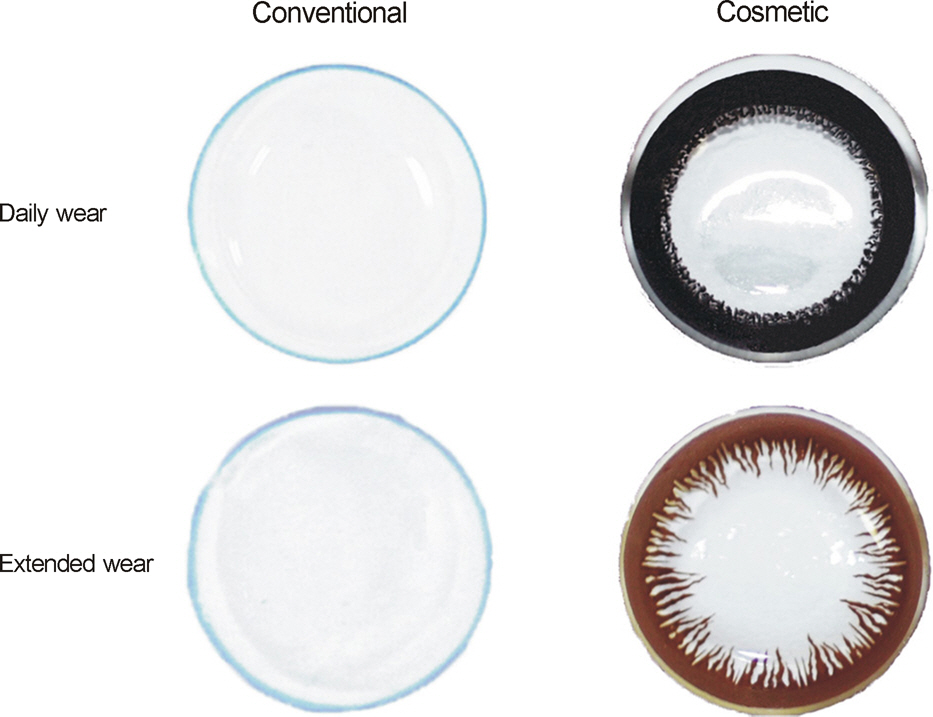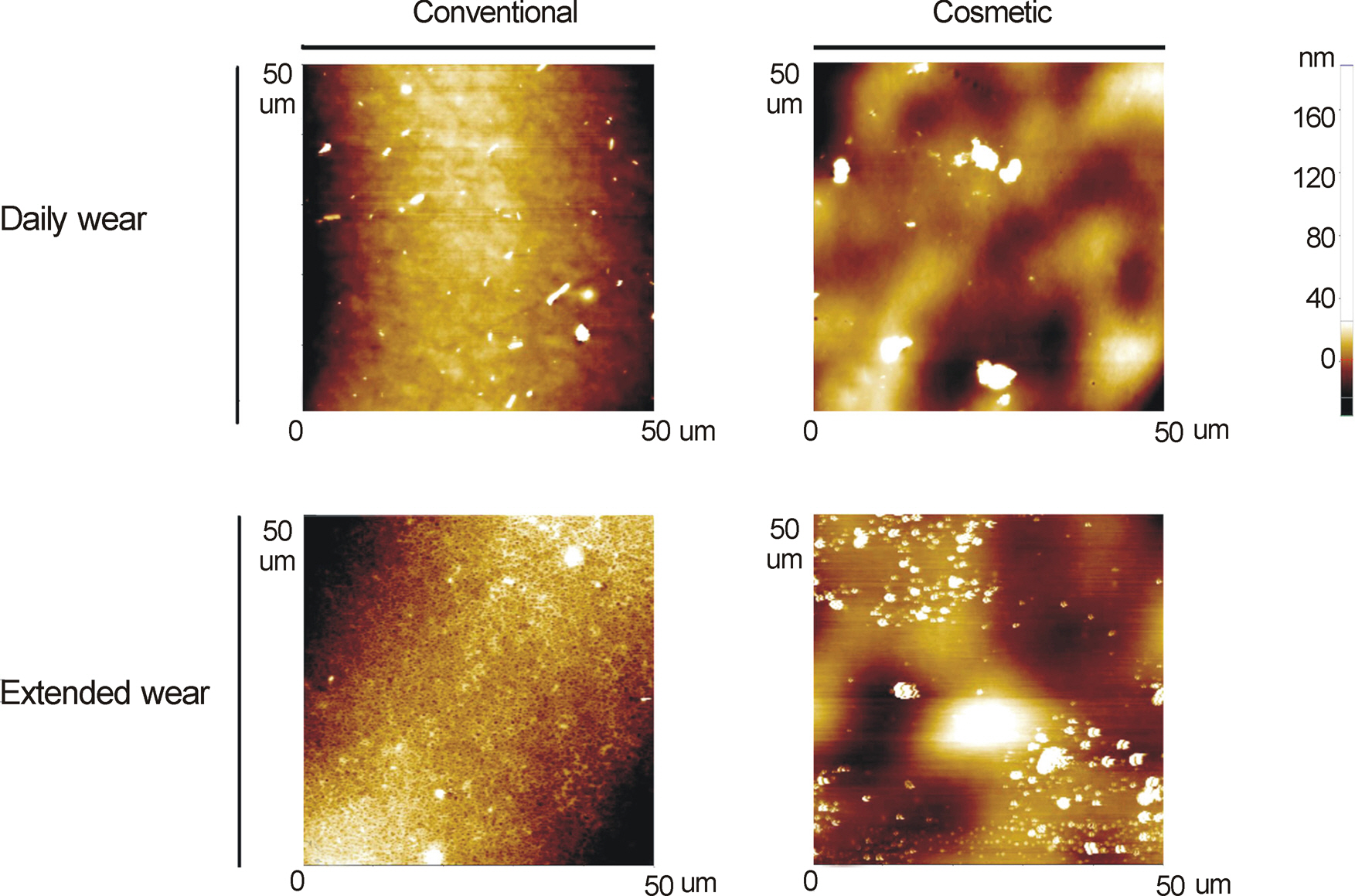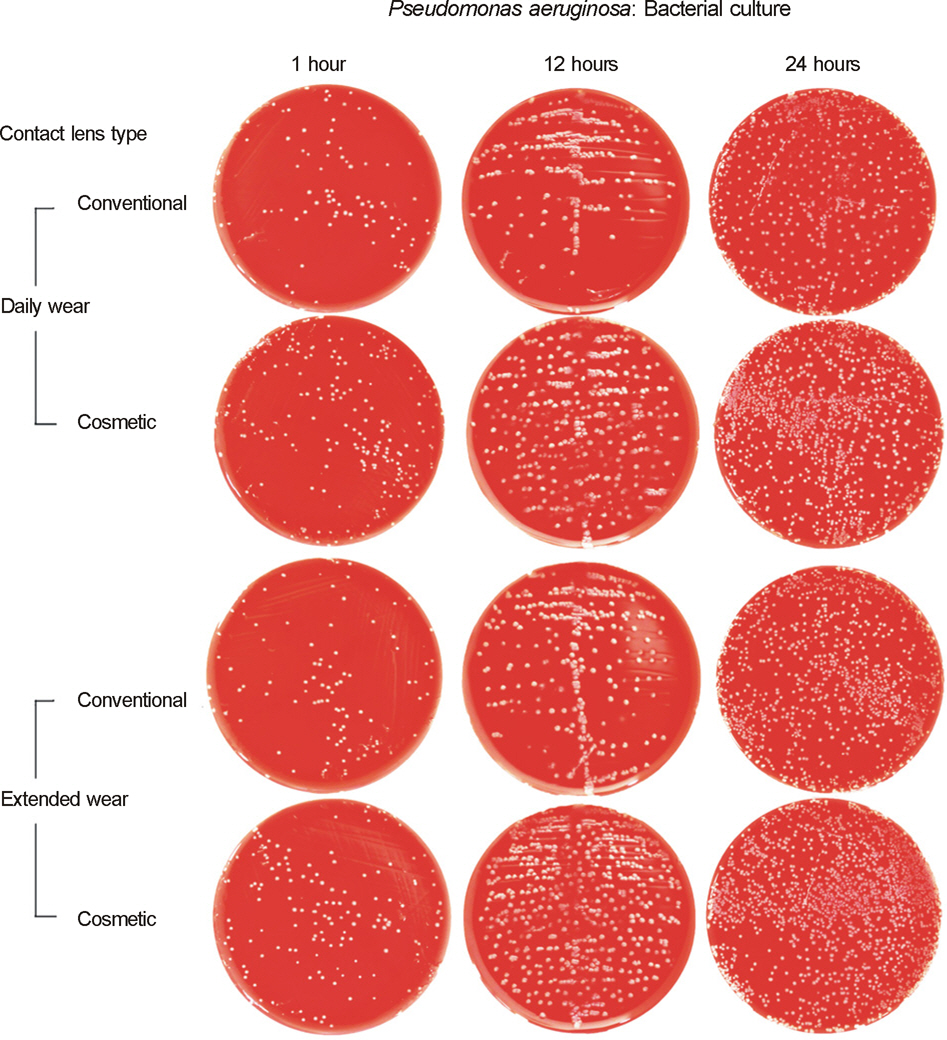J Korean Ophthalmol Soc.
2014 May;55(5):646-655. 10.3341/jkos.2014.55.5.646.
Comparison of Surface Roughness and Bacterial Adhesion between Cosmetic Contact Lenses and Conventional Contact Lenses
- Affiliations
-
- 1Institute of Vision Research, Department of Ophthalmology, Yonsei University College of Medicine, Seoul, Korea. shadik@yuhs.ac
- 2Division of Microbiology, Department of Laboratory Medicine, Gangnam Severance Hospital, Yonsei University College of Medicine, Seoul, Korea.
- 3Morphology Lab., Yonsei Biomedical Research Institute, Seoul, Korea.
- 4Institute of Corneal Dystrophy Research, Department of Ophthalmology, Yonsei University College of Medicine, Seoul, Korea.
- KMID: 2218084
- DOI: http://doi.org/10.3341/jkos.2014.55.5.646
Abstract
- PURPOSE
To determine the surface roughness of cosmetic and conventional contact lenses (CLs) and their susceptibility to bacterial adhesion.
METHODS
Concave surface roughness of cosmetic and conventional hydrogel (Etafilcon A) CLs was measured by atomic force microscopy (AFM) and scanning electron microscopy (SEM). In particular, the surface of the color tinted area of cosmetic CLs was measured. CLs were immersed into a bacterial solution of Pseudomonas aeruginosa for 1, 12, or 24 hours and culture of P. aeruginosa that had adhered to the CLs was performed.
RESULTS
Concave surface roughness of cosmetic CLs significantly increased compared with conventional CLs by AFM (p < 0.05). Bacterial colony formation of P. aeruginosa adhering to cosmetic CLs within one hour significantly increased compared with conventional CLs (p = 0.047). Adhesions of P. aeruginosa to CLs within one hour was found to correlate significantly with the surface roughness of CL (r > 0.9, p < 0.05). By SEM, P. aeruginosa had adhered to the color-tinted area more than to the non-color-tinted area of cosmetic CLs.
CONCLUSIONS
Surface of cosmetic CLs was significantly rougher and initial adhesion of bacteria was higher to cosmetic CLs than to conventional CLs. In particular, an increased number of bacteria was found to be adhered to the color-tinted area of cosmetic CLs. Initial bacterial adhesion is important because it is the first stage of bacterial attachment process to any surface. After then, the adherent bacteria can progress to form a biofilm. Increased surface roughness of CLs contributes to opportunities for the CL to come into contact with bacteria, and thus, initial bacterial adhesion increases. In this study, it is clear that cosmetic CLs are more vulnerable to bacterial adhesion. To avoid serious complications, such as bacterial keratitis, the manufacturing process for smoothing and treating the surface in order to inhibit bacterial adhesion should be developed in the future.
Keyword
MeSH Terms
Figure
Cited by 1 articles
-
Comparison and Investigation of the National Standards for Tinted Contact Lenses between Various Countries
Sang Ah Kim, Ji Won Jung, Kyoung Yul Seo, Hyung Keun Lee, Eung Kweon Kim, Tae Im Kim
J Korean Ophthalmol Soc. 2015;56(11):1692-1698. doi: 10.3341/jkos.2015.56.11.1692.
Reference
-
References
1. Efron N, Morgan PB, Woods CA. International survey of contact lens prescribing for extended wear. Optom Vis Sci. 2012; 89:122–9.
Article2. Efron N, Morgan PB, Woods CA. Survey of contact lens prescribing to infants, children, and teenagers. Optom Vis Sci. 2011; 88:461–8.
Article3. Morgan PB, Efron N, Woods CA. Determinants of the frequency of contact lens wear. Eye Contact Lens. 2013; 39:200–4.
Article4. Efron N, Morgan PB, Woods CA. An international survey of daily disposable contact lens prescribing. Clin Exp Optom. 2013; 96:58–64.5. Park YM, Hahn TW, Choi SH, et al. Acanthamoeba Keratitis Related to Cosmetic Contact Lenses. J Korean Ophthalmol Soc. 2007; 48:991–4.6. Song JS, Lee H, Kim JW, et al. The effects of cheap tinted contact lenses on corneal swelling and ocular surface inflammation. J Korean Ophthalmol Soc. 2008; 49:1888–93.
Article7. Lim TH, Lee JR, Choi KY, et al. Corneal melting And descemetocele resulting from noninfectious keratitis related to the cosmetic contact lenses. J Korean Ophthalmol Soc. 2009; 50:774–8.
Article8. Park SJ, Lee SM, Kim MK, et al. Cosmetic contact lens-related complications: 9 cases. J Korean Ophthalmol Soc. 2009; 50:927–35.
Article9. Sauer A, Bourcier T. Microbial keratitis as a foreseeable complication of cosmetic contact lenses: a prospective study. Acta Ophthalmol. 2011; 89:e439–42.
Article10. Steinemann TL, Fletcher M, Bonny AE, et al. Over-the-counter decorative contact lenses: Cosmetic or Medical Devices? A Case Series. Eye Contact Lens. 2005; 31:194–200.
Article11. Steinemann TL, Pinninti U, Szczotka LB, et al. Ocular complications associated with the use of cosmetic contact lenses from unlicensed vendors. Eye Contact Lens. 2003; 29:196–200.
Article12. McKelvie J, Patel D, McGhee C. Cosmetic contact lens-related Acanthamoeba keratitis. Clin Experiment Ophthalmol. 2009; 37:419–20.13. Williams D. Great expectations and the grapes of wrath: contamination of contact lenses. Med Device Technol. 1999; 10:10–3.14. Giraldez MJ, Resua CG, Lira M, et al. Contact lens hydrophobicity and roughness effects on bacterial adhesion. Optom Vis Sci. 2010; 87:E426–31.
Article15. Burnham GW, Cavanagh HD, Robertson DM. The impact of cellular debris on Pseudomonas aeruginosa adherence to silicone hydrogel contact lenses and contact lens storage cases. Eye Contact Lens. 2012; 38:7–15.
Article16. Dutta D, Cole N, Willcox M. Factors influencing bacterial adhesion to contact lenses. Mol Vis. 2012; 18:14–21.17. Vijay AK, Zhu H, Ozkan J, et al. Bacterial adhesion to unworn and worn silicone hydrogel lenses. Optom Vis Sci. 2012; 89:1095–106.
Article18. Willcox MD. Microbial adhesion to silicone hydrogel lenses: a review. Eye Contact Lens. 2013; 39:61–6.19. Willcox MD, Holden BA. Contact lens related corneal infections. Biosci Rep. 2001; 21:445–61.
Article20. Robertson DM. The effects of silicone hydrogel lens wear on the corneal epithelium and risk for microbial keratitis. Eye Contact Lens. 2013; 39:67–72.
Article21. Bailey CS. A review of relative risks associated with four types of contact lenses. Cornea. 1990; 9(Suppl 1):S59–61. discussion S62-3.
Article22. Willcox MD, Harmis N, Cowell , et al. Bacterial interactions with contact lenses; effects of lens material, lens wear and microbial physiology. Biomaterials. 2001; 22:3235–47.
Article23. Bruinsma GM, van der Mei HC, Busscher HJ. Bacterial adhesion to surface hydrophilic and hydrophobic contact lenses. Biomaterials. 2001; 22:3217–24.
Article24. McGlinchey SM, McCoy CP, Gorman SP, Jones DS. Key biological issues in contact lens development. Expert Rev Med Devices. 2008; 5:581–90.
Article25. Loyola-Rodriguez JP, Zavala-Alonso V, Reyes-Vela E, et al. Atomic force microscopy observation of the enamel roughness and depth profile after phosphoric acid etching. J Electron Microsc (Tokyo). 2010; 59:119–25.
Article26. Lira M, Santos L, Azeredo J, et al. Comparative study of silicone-hydrogel contact lenses surfaces before and after wear using atomic force microscopy. J Biomed Mater Res B Appl Biomater. 2008; 85:361–7.
Article27. Giraldez MJ, Serra C, Lira M, et al. Soft contact lens surface profile by atomic force microscopy. Optom Vis Sci. 2010; 87:E475–81.
Article28. Desrousseaux C, Sautou V, Descamps S, Traore O. Modification of the surfaces of medical devices to prevent microbial adhesion and biofilm formation. J Hosp Infect. 2013; 85:87–93.
Article29. Mueller RF, Characklis WG, Jones WL, Sears JT. Characterization of initial events in bacterial surface colonization by two Pseudomonas species using image analysis. Biotechnol Bioeng. 1992; 39:1161–70.30. Chen L, Wen YM. The role of bacterial biofilm in persistent infections and control strategies. Int J Oral Sci. 2011; 3:66–73.
Article31. Fletcher EL, Weissman BA, Efron N, et al. The role of pili in the attachment of Pseudomonas aeruginosa to unworn hydrogel contact lenses. Curr Eye Res. 1993; 12:1067–71.32. Evans DJ, Fleiszig SM. Microbial keratitis: could contact lens material affect disease pathogenesis. Eye Contact Lens. 2013; 39:73–8.33. Vermeltfoort PB, Rustema-Abbing M, de Vries J, et al. Influence of day and night wear on surface properties of silicone hydrogel contact lenses and bacterial adhesion. Cornea. 2006; 25:516–23.
Article
- Full Text Links
- Actions
-
Cited
- CITED
-
- Close
- Share
- Similar articles
-
- Characteristics and Complications of Cosmetic Contact Lens
- Infectious Keratitis Associated with Contact Lenses
- The Effect of Astigmatism Correction in Myopic Astigmatism by Toric Lenses: Comparison with Hard Contact Lenses
- Guide for Successful Scleral Lens Fitting
- Characteristics of Silicone Hydrogel Contact Lenses Commercially Available in Korea






